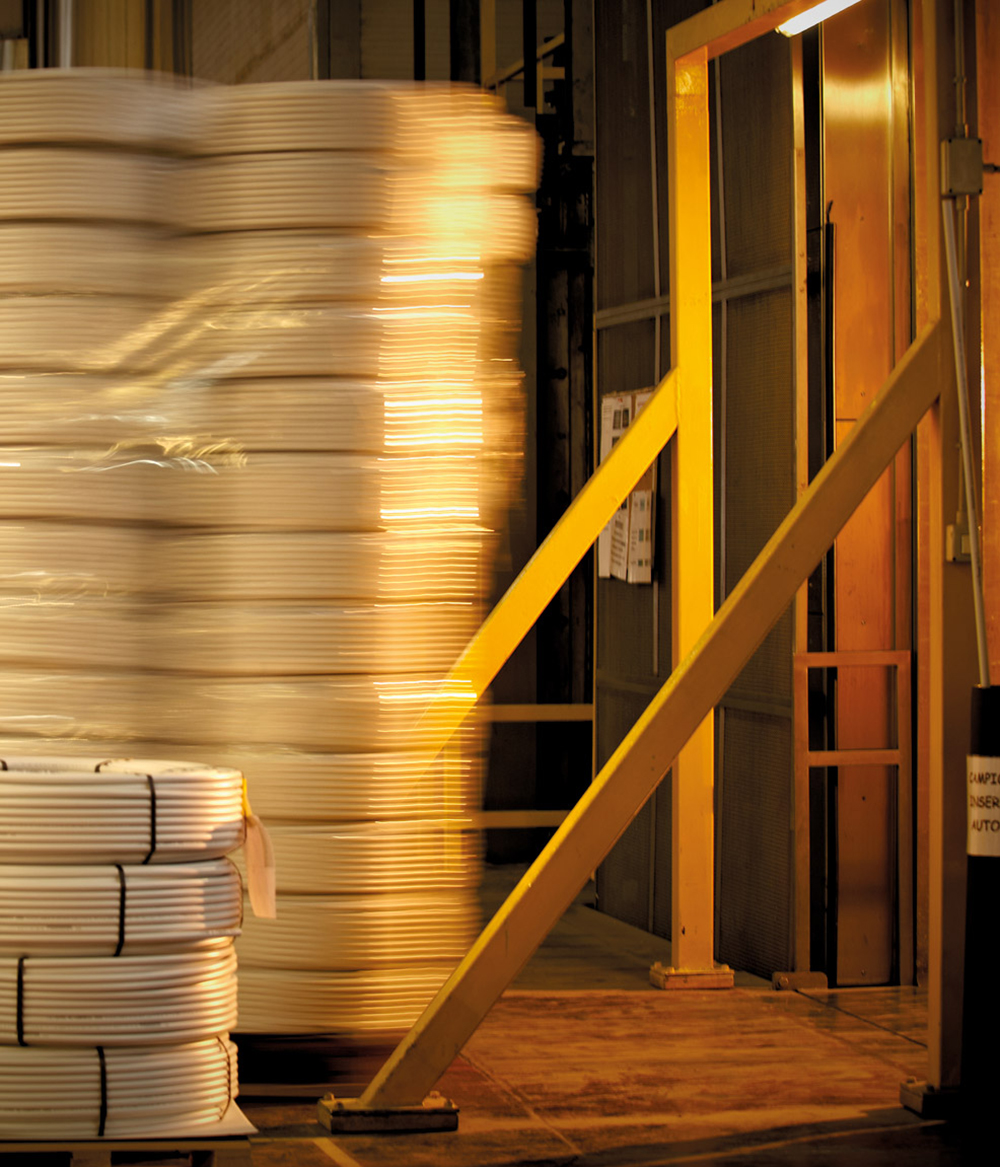By definition, multilayer pipes are produced by alternating different materials in order to combine their chemical and mechanical characteristics.
Pexal and Mixal both have an inner layer of type B cross-linked polyethylene. A film of adhesive bonds the latter to the middle layer, made of aluminium. Another adhesive film is applied before the outer layer of the pipe, in high-density polyethylene for the Mixal range, and again in PE-Xb for Pexal.
The selection of raw materials is the first key to ensuring quality and reliability throughout the pipe’s entire life cycle. Next comes the precision of the workmanship.
What is cross-linked polyethylene, and how does “cross-linking” occur?
The inner layers of Pexal and Mixal and the outer layer of Pexal are made of cross-linked type B polyethylene. The multilayer pipes on the market are produced using different processing methods, which refer to a standard - the German DIN 16892 - that stipulates the “minimum degree” of cross-linking depending on the method applied.

In fact there are several processes that lead to a similar result: the main methods use peroxides (type A cross-linking), silanes (type B), radiation (type C) and azo compounds (type D). Keep in mind that the different technologies do not lead to a better or worse result: the quality of the product is directly dependent on the precision and conformity of the workmanship with the relevant standard.
As mentioned, Valsir uses PE-Xb. This process is performed when the production of the pipe is completed, using specific steam tanks. The decision to carry out the process in-house is linked to the complete control and traceability of each stage of production, resulting in a guarantee of full compliance with current standards.
Performance that combines the benefits of each material
As already mentioned, the peculiarity of multilayer pipes is that they are able to exploit the synergy of the materials used. For example, the natural corrosion resistance of plastics and the durability of aluminium with respect to high pressures and temperatures.
Even the adhesive that binds the different layers of materials is the result of years of research, in order to optimise the resilience over time without interfering with the dynamic characteristics of the multilayer pipe.

The heart of the multilayer solution remains the aluminium, the middle layer of the pipes. The material used is virgin aluminium, the flexibility of which is maintained uniformly by TIG butt welding. With this method, the thickness is constant over the entire section of the pipe, which has no points that are more or less rigid than others (with obvious benefits during laying).
One of the greatest strengths of the aluminium layer is its ability to act as a barrier against light and oxygen, thus hindering the proliferation of algae and bacteria inside the pipes.
Just a brief observation, on the other hand, with regard to the high-density polyethylene that constitutes the outer layer of the Mixal range. Bear in mind that the main application in this case is radiant heating or cooling systems, which means that the installer will have to make a lot of bends, and thus the manageability of the multilayer pipe becomes the most important practical characteristic. In this sense, PE is thus preferred over PE-Xb for its greater flexibility.
The differences (and similarities) between Pexal and Mixal
One of the key differences between Mixal and Pexal is the thickness of the aluminium. We mentioned that due to its most common application Mixal prioritises flexibility, which is why it uses a thinner aluminium layer (though without compromising its mechanical strength in any way).
Another point worthy of note is the available range. Mixal is produced with diameters of 14 to 32 mm, while Pexal goes up to 110 mm to satisfy a broader range of building requirements.

Both solutions can be used for a wide variety of applications, from sanitary systems to high- and low-temperature heating systems (i.e. radiant systems, but also radiators), not to mention for compressed air. Both ranges are approved in all four classes envisaged by product regulations and according to the most restrictive standards (10 bar).
Multilayer pipes are immune to corrosion and are the best alternative to metal pipes also because of the lightness of the materials employed, a crucial factor for minimising the impact on consumption and performance when installed on a boat.
Due to the wide variety of uses, both Pexal and Mixal are available in bars or rolls, up to 500 m lengths. The pipes are also supplied covered with 6 to 13 mm of heat-insulating sheathing (even 25 mm on request) or with single or double corrugated sheathing (so with double piping included).
Multilayer also means fittings
When we talk about a “multilayer system” we’re actually referring not only to pipes but also to an extensive selection of fittings and accessories suited for any installation.
These include classic brass screw fittings (Pexal Twist), press-fit solutions, which also comprise ranges in brass (Pexal Brass), and also the more modern plastic variant made with the PPSU “technopolymer” (Bravopress).

Speaking of polymers, it’s worth mentioning that Pexal is the only product that makes it possible to use full-bore fittings (PexalEasy), which unlike all other solutions avoid the reduction of the bore section at the hose barb.
Finally, the plastic material of the fittings incorporates some of the winning characteristics of the multilayer pipe itself: prevention of scaling, reduced pressure drops, chemical resistance to even the most severe treatments (e.g. sanitisation of water networks in hospitals)..
 Italiano
Italiano
 English
English
 Deutsch
Deutsch
 Français
Français
 Español
Español
 Greek
Greek